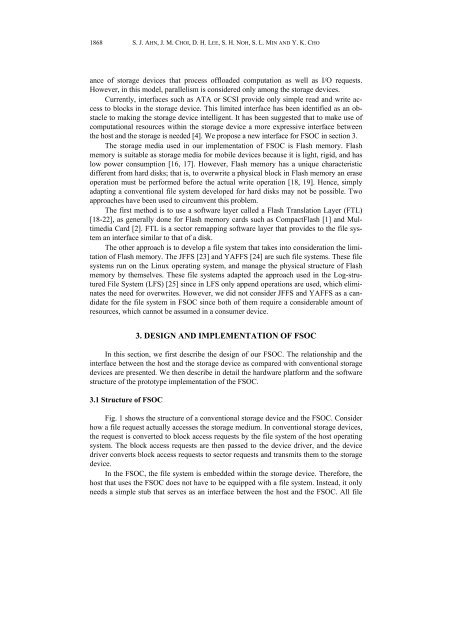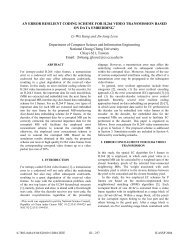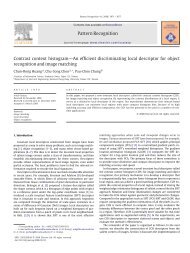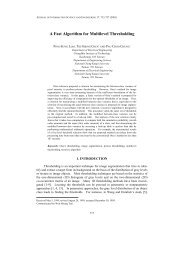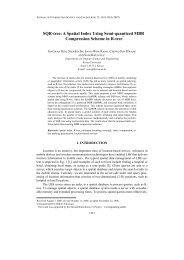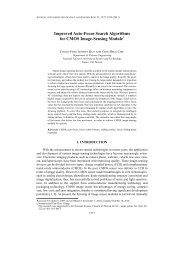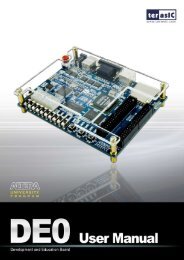Design, Implementation, and Performance Evaluation of Flash ...
Design, Implementation, and Performance Evaluation of Flash ...
Design, Implementation, and Performance Evaluation of Flash ...
Create successful ePaper yourself
Turn your PDF publications into a flip-book with our unique Google optimized e-Paper software.
1868<br />
S. J. AHN, J. M. CHOI, D. H. LEE, S. H. NOH, S. L. MIN AND Y. K. CHO<br />
ance <strong>of</strong> storage devices that process <strong>of</strong>floaded computation as well as I/O requests.<br />
However, in this model, parallelism is considered only among the storage devices.<br />
Currently, interfaces such as ATA or SCSI provide only simple read <strong>and</strong> write access<br />
to blocks in the storage device. This limited interface has been identified as an obstacle<br />
to making the storage device intelligent. It has been suggested that to make use <strong>of</strong><br />
computational resources within the storage device a more expressive interface between<br />
the host <strong>and</strong> the storage is needed [4]. We propose a new interface for FSOC in section 3.<br />
The storage media used in our implementation <strong>of</strong> FSOC is <strong>Flash</strong> memory. <strong>Flash</strong><br />
memory is suitable as storage media for mobile devices because it is light, rigid, <strong>and</strong> has<br />
low power consumption [16, 17]. However, <strong>Flash</strong> memory has a unique characteristic<br />
different from hard disks; that is, to overwrite a physical block in <strong>Flash</strong> memory an erase<br />
operation must be performed before the actual write operation [18, 19]. Hence, simply<br />
adapting a conventional file system developed for hard disks may not be possible. Two<br />
approaches have been used to circumvent this problem.<br />
The first method is to use a s<strong>of</strong>tware layer called a <strong>Flash</strong> Translation Layer (FTL)<br />
[18-22], as generally done for <strong>Flash</strong> memory cards such as Compact<strong>Flash</strong> [1] <strong>and</strong> Multimedia<br />
Card [2]. FTL is a sector remapping s<strong>of</strong>tware layer that provides to the file system<br />
an interface similar to that <strong>of</strong> a disk.<br />
The other approach is to develop a file system that takes into consideration the limitation<br />
<strong>of</strong> <strong>Flash</strong> memory. The JFFS [23] <strong>and</strong> YAFFS [24] are such file systems. These file<br />
systems run on the Linux operating system, <strong>and</strong> manage the physical structure <strong>of</strong> <strong>Flash</strong><br />
memory by themselves. These file systems adapted the approach used in the Log-stru-<br />
tured File System (LFS) [25] since in LFS only append operations are used, which eliminates<br />
the need for overwrites. However, we did not consider JFFS <strong>and</strong> YAFFS as a c<strong>and</strong>idate<br />
for the file system in FSOC since both <strong>of</strong> them require a considerable amount <strong>of</strong><br />
resources, which cannot be assumed in a consumer device.<br />
3. DESIGN AND IMPLEMENTATION OF FSOC<br />
In this section, we first describe the design <strong>of</strong> our FSOC. The relationship <strong>and</strong> the<br />
interface between the host <strong>and</strong> the storage device as compared with conventional storage<br />
devices are presented. We then describe in detail the hardware platform <strong>and</strong> the s<strong>of</strong>tware<br />
structure <strong>of</strong> the prototype implementation <strong>of</strong> the FSOC.<br />
3.1 Structure <strong>of</strong> FSOC<br />
Fig. 1 shows the structure <strong>of</strong> a conventional storage device <strong>and</strong> the FSOC. Consider<br />
how a file request actually accesses the storage medium. In conventional storage devices,<br />
the request is converted to block access requests by the file system <strong>of</strong> the host operating<br />
system. The block access requests are then passed to the device driver, <strong>and</strong> the device<br />
driver converts block access requests to sector requests <strong>and</strong> transmits them to the storage<br />
device.<br />
In the FSOC, the file system is embedded within the storage device. Therefore, the<br />
host that uses the FSOC does not have to be equipped with a file system. Instead, it only<br />
needs a simple stub that serves as an interface between the host <strong>and</strong> the FSOC. All file


